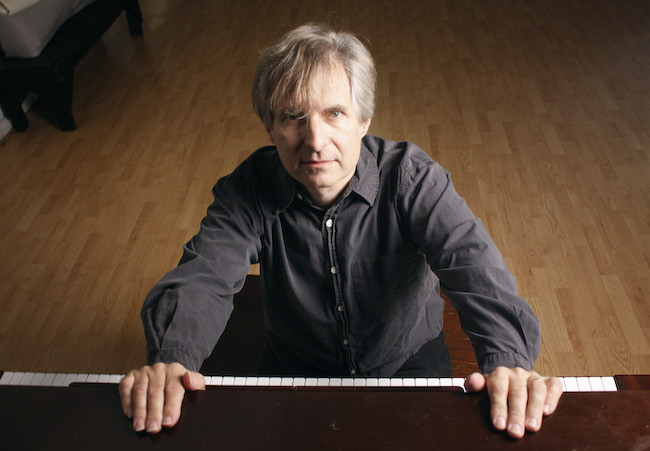Oct 28, 2025 10:47 AM
In Memoriam: Jack DeJohnette, 1942–2025
Jack DeJohnette, a bold and resourceful drummer and NEA Jazz Master who forged a unique vocabulary on the kit over his…

Chris Stamey has written new material in the style of the Great American Songbook.
(Photo: Daniel Coston)Aging rock musicians from Rod Stewart to Bob Dylan have turned to the Great American Songbook to revive their creative juices. But Chris Stamey, co-founder of the dBs and producer of such indie-rock acts as Alejandro Escovedo, Le Tigre and Yo La Tengo, has taken a different approach.
Instead of singing other people’s compositions, he’s rearranged a handful of his old songs and written a raft of new ones that are akin to material for a 1958 recording session by Frank Sinatra or Ella Fitzgerald—complete with strings, horns and guest solos by jazz stars. Stamey is releasing the results on a two-disc set, New Songs For The 20th Century (Omnivore), and as a sheet-music book of the same title.
“More and more I feel pop music is living in a harmonic wasteland,” Stamey said from his home in Chapel Hill, North Carolina. “Early rock songs had exciting rhythms but simple changes. But Paul McCartney had a dad who knew the American Songbook tradition, and he started putting diminished chords and sharp-nine chords in Beatles songs, and a lot of people followed his lead. But when the Swedish songwriters took over, that all went away; it all became become four chords again.”
Though Stamey is a likable vocalist himself, he doesn’t sing on the new album. Instead, his compositions are handled by a handful of stars (pop-rock artist Marshall Crenshaw and Whiskeytown alumna Caitlin Cary) and a host of gifted, lesser-known singers, such as Kirsten Lambert and Django Haskins. Though the music is spiced by guest soloists—including saxophonist Branford Marsalis and guitarists Bill Frisell and Nels Cline—the core band is anchored by saxophonist Will Campbell, a veteran of Harry Connick Jr.’s band and head of the jazz department at the University of North Carolina at Charlotte.
“I’ve been friends since grade school with Dan Davis, the drummer, and Dana, Chris’ wife,” Lambert said. “Four years ago, Chris wanted to send some of his songs to Diana Krall with jazz arrangements and my vocals—in hopes she might record them. Then he called me and said, ‘This should be your record.’ At first, we were rearranging his old songs, but when he got his childhood piano from his father, he started writing new songs. Even when I said, ‘Chris, I have more than enough songs for my album,’ he kept writing.”
When Stamey began collaborating with rocker Alex Chilton in the 1970s, he and Chilton would go out together to see Charles Mingus and Rahsaan Roland Kirk. Stamey also knew Frisell from that time, when the punk and jazz worlds intersected at Manhattan’s Knitting Factory.
“Even when I was writing rock songs,” Stamey said, “I always tried to have a really tight connection between the words and the music. The music has to match the cadence and intent of the lyrics. I never write melodies without words—or vice versa. On the song ‘I Don’t Believe In Romance,’ the final syllable of ‘romance’ lands on the ninth of an unexpected minor chord, which in this context lets you know she’s lying. It’s so much fun to write like that.” DB

Jack DeJohnette boasted a musical resume that was as long as it was fearsome.
Oct 28, 2025 10:47 AM
Jack DeJohnette, a bold and resourceful drummer and NEA Jazz Master who forged a unique vocabulary on the kit over his…

Goodwin was one of the most acclaimed, successful and influential jazz musicians of his generation.
Dec 9, 2025 12:28 PM
Gordon Goodwin, an award-winning saxophonist, pianist, bandleader, composer and arranger, died Dec. 8 in Los Angeles.…

Flea has returned to his first instrument — the trumpet — and assembled a dream band of jazz musicians to record a new album.
Dec 2, 2025 2:01 AM
After a nearly five-decade career as one of his generation’s defining rock bassists, Flea has returned to his first…

Nov 13, 2025 10:00 AM
For results of DownBeat’s 90th Annual Readers Poll, complete with feature articles from our December 2025 issue,…

To see the complete list of nominations for the 2026 Grammy Awards, go to grammy.com.
Nov 11, 2025 12:35 PM
The nominations for the 2026 Grammy Awards are in, with plenty to smile about for the worlds of jazz, blues and beyond.…








